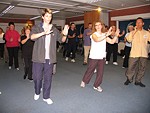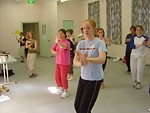Tai Chi and Martial Art Applications
Dr Paul Lam Most people who practice tai chi do so for its great health benefits. Although it is originally a martial art, tai chi is remarkably effective for health. To use its martial art applications, one needs to practice sparring and risk higher chance of injury.
Tai Chi and Martial Art by Paul Lam
Tai chi was originally a martial art. And while nowadays the majority of people practise it strictly for its health benefits, the martial art component is extremely important since it’s an integral part of tai chi. The martial art training consists of several different stages. Let’s look at them and relate them to your tai chi goals. Note that if your goal in doing tai chi is strictly for health, the martial art stages that involve higher risk of injuries are not suitable nor necessary.
The Different Stages of Martial Art Training

The next stage, the internal aspect, involves mental balance-improving the clarity of mind and relaxation as well as building up your internal strength and structures such as bones and ligaments. You can also gain these from practicing the forms, keeping your mind focused and using visualisation techniques.
By now, you should be acquiring the skill to move your body in the most effective way for combat, which again can be gained from practicing the forms correctly.
As you progress, you’ll learn the martial art intention of the movements and the correct posture including where your hands and feet should be as well as where to apply force, and how to absorb, redirect and control the incoming force. You’ll also understand where the internal force should be and how to direct it. In other words, you’ll learn how to control your own body and mind so that you can best control your opponent.

Practising these can be enjoyable, challenging and fulfilling. This practice will bring you to a higher level of tai chi. In fact it will also improve your skill as a martial artist. For example, if you with your training were to fight someone of similar size who had spent an equal amount of training time in another physical exercise, the chances are you’ll win the fight. That’s because most of the components of an effective martial artist-strength, inner power, positions, effective usage of the body, clarity of the mind-are exactly what you’ve already practiced for better health.
The Final Stage of Tai Chi Training For Martial Art
Now we move to the ultimate
purpose of martial art: total control of your opponent. This could mean severely
injuring him or her. While tai chi is based on the philosophy of yin-yang harmony
and balance of nature, it was, after all, designed to be an effective martial
art. Most tai chi movements show martial intention and have the potential to
hurt someone. For example Golden Guard Stamping Foot aims at hitting the chin,
top of the head and punching the abdomen with internal force. Such thoughts
send shivers down my spine. I, as well as most of my tai chi friends when we
practice, certainly don’t want to think about hurting anyone. Naturally, there
are different levels of control. Ideally a high-level tai chi practitioner can
control his opponent without hurting him. But to reach that kind of skill and
control requires a lot of special training. And the more real the training the
more effective it will be. Bear in mind, though, that it isn’t always possible
to achieve perfect control. Even the most skilful practitioner could make a
minor mistake, which could result in serious injury to either party. Therefore,
the more real the training the more chance of injury.

If you want to experiment, have a friend throw a punch at you as fast as he can. (Make sure that he isn’t actually going to reach you) One of the most accepted tai chi ways to receive a punch is to use one hand to touch on to his wrist, the other hand at his elbow. Ideally your joints would be loosened and your internal force would be ready to absorb and redirect the incoming force. Your body would be totally relaxed, in the right stance and balanced well enough so that you could move back without compromising your balance. You would try to receive your friend as fast as he comes.
Chances are, you’d find that difficult. Most likely your external muscles would become tense. It takes the average tai chi practitioner an immense amount of practice before that elastic loosening force is ready to absorb force. The same goes for the hands being placed in just the right position. Get your friend to punch from different directions and see how long you’d have to train to receive an unpredictable punch from anywhere in a fully ready tai chi way. It’s likely that this could be an impossible stage to achieve for many tai chi practitioners. You and your friend would have higher chances of injury if you practise this at close range.
For Beginners
When you try to teach a new student the fighting aspect, the student will naturally tense up. Fighting is associated with the classic fright and flight reaction; thinking of it makes people naturally tense up. This impedes the learning of tai chi. When people are tense, they will have difficulty learning the essential principles of tai chi such as slowing down, cleansing the mind, loosening the muscles, focusing on precision, body awareness and weight shifting. Therefore for beginners it’s much more effective to work on the essential principles without too much emphasis on the martial art application.
Pushing Hands
Pushing Hands in tai chi is an ingenious invention. It’s a two-man drill to help the twosome feel each other’s force and experience some aspects of combat. It can be fun if the participants stay within the artistic aspect. This isn’t easy to do. The subtlety of push hands takes a great deal of time to acquire, and very often people use harsh force to try to “win” in pushing, predisposing the opponent to injury.
While pushing hands is a useful tool, it isn’t a necessary practice in order to reach a high level in tai chi. No matter how much push hands a person does, he or she won’t understand tai chi without practising the forms.
Push hands has acquired a magical reputation that sometimes leads people to lose prospective. For years the National Push Hands Competition in China was won by weight lifters with no tai chi experience. Now, there’s a rule that all competitors have to demonstrate a set of tai chi before they’re eligible for the competition. The way I interpret that is while push hands is a great technique; it’s very useful but not necessarily as magical in combat as some of us think. The magic of tai chi is in its health-giving property that comes from regular and intelligent practice. If tai chi were a pill, it would be the best medicine ever with or without push hand practice.
Conclusion
Tai chi is a most effective martial art, but training to use it for fighting is another matter. The training techniques that lead to the actual fight, such as sparring and fast punches, are the final stage of the martial art components. This stage has a higher chance of injury. Nowadays, there is little chance that we need to physically fight for our lives, and if that happens we would have little chance against anyone with a gun no matter how skilful we are.
The training of tai chi in the slow style is incredibly effective for building health and strength. Many studies have shown these training methods to be very effective for building a strong body and mind. In fact, this is why tai chi is gaining so much popularity.
The essential principles, which make tai chi an effective martial art, are equally effective for health improvement. Understanding them helps to correct the forms, improves inner strength and is essential to reach a high level of tai chi. The final stage of martial art training is not necessary to reach a higher level and is fraught with a significantly higher risk of injury. Therefore you should carefully assess the risks and benefits before embarking on this level.
A POSITION STATEMENT ON THE TAI CHI FOR ARTHRITIS PROGRAM
by Paul Lam

Anyone who is involved in teaching or practising Tai Chi for Arthritis should avoid the final stage of martial art application. Understanding the essential principles is important; visualisation should be used for practice. Sparing, push hands, or training of fast force-delivering movements are not appropriate. Demonstrating the intention of a movement should not be done with physical contact to avoid possibility of injury. Students or instructors who wish to pursue these endeavours should do so outside the area of this program.
